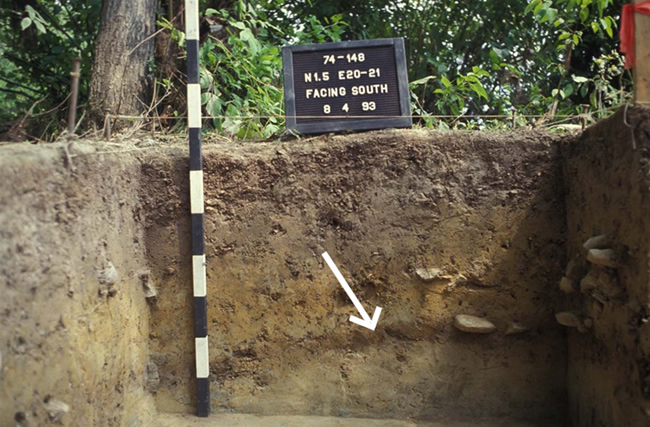Archaeology provides proxy climate data. The major source of paleontology fossils in Maine is archaeology. As and example, about 4000 years ago swordfish disappear from coastal sites. This species is sea surface temperature dependent. The disappearance suggests sea surface temperature cooling by 4000 years ago. This is coincident with terrestrial temperature reconstructions. The cooling is also reflected in shifts from warm-water species like oysters and quahogs to soft-shell clams. After circa 3000 years ago there is an increase in boreal species (mostly moose and small furbearers), again paralleling terrestrial indicators for cooling. In addition, coastal sites reflect differential erosion along the Maine coast. Some may be attributed to different rates of subsidence. Maximum ages of sites provide the overall coastal pattern. Finally, archaeology has sponsored terrestrial data such as water levels in lakes and rivers which is generally correlative with a mid-Holocene warming and drying. The increased number of sites higher up on second and third order streams reflects higher water levels increasing to the historic period.
Climate and environmental change directly influence research on archaeology of Maine at a number of different scales. With a primary focus on prehistoric Native American archaeology, my research is most directly concerned with what may be called traditional, or long term climate change that influenced human subsistence and settlement. Although perhaps more traditional in nature, new research is constantly injecting major factors that influence archaeological interpretation, such as the current research of three graduate students concerning Younger Dryas glacial readvance and lake level change (Pelletier); sea level change and oyster biology (Leach); and 3) mid Holocene lake level change and fish weir use at Sebasticook Lake (Miller).
The topic of rapid climate change presents new challenges for prehistoric archaeology. Ice core data provides unprecedented resolution of proxy data on climate change, with unprecedented time depth. Short term changes may dramatically influence resource availability, sometimes with catastrophic results. The scale of these changes are typically beyond the resolution of archaeological dating except in rare cases such as El Nino events in South America that have catastrophic floods associated. Rapid climate change is nonetheless an important new factor that must be addressed as regional manifestations of climate and environmental change become better known. For example, rapid onset of the Younger Dryas in Maine directly influences current Paleoindian research at the University of Maine (ca., 10,500 to 11,000 radiocarbon years before present).
With recent public acceptance of global warming, new environmental manifestations are reported almost daily. From the perspective of my collaborative research in Alaska, melting glaciers and permafrost are ominous signs for archaeology as well as broad world concerns. Monitoring glacial ice for newly exposed wood, bone, and skin artifacts has become another regular archaeological practice. Rising sea level in Maine has equally devastating results for coastal shell middens. One of the most informative archaeological resources in all of Maine may be lost, not in the next year or decade, but within a few generations of Maine archaeologists. Given the labor intensive nature of this research, the potential deadlines imposed by rising sea level and changing storm patterns (on top of equally significant human impacts) require serious consideration. These threats were part of the justification for our recent grant from the Maine Academic Prominence Initiative (MAPI) to fund annual archaeological field schools on Maine's coastal shell middens. The archaeological concerns are among the many societal impacts of climate change in ancient and modern times.
Her research in Maine focuses on understanding how Late Pleistocene and Holocene climate influenced human occupation through dynamic landscape changes. The basis for this work was an interdisciplinary study of archaeological sites in the central Penobscot Valley, combined with geological and paleoenvironmental data from the region.
One result of this work has modified archaeologists' view of how the region's earliest inhabitants used portions of Maine. Previously, Paleoindian site location models focused on high, well-drained sandy areas in the search for evidence of the region's earliest inhabitants. While these factors are important in the southern portions of the state, Kelley's recognition of a postglacial landscape dominated by extensive lakes in central Maine has brought attention to the importance of these features in the identification of early archaeological sites.
Analysis of stratigraphic sections from more than 25 sites in the Penobscot Valley has produced a record of environmental change as reflected by the sediments deposited by the Penobscot River and its tributaries in the last 10,000 years. By using radiocarbon samples and diagnostic archaeological artifacts, buried soils have been dated and correlated with the paleohydrological record for the region. One goal of this research is to determine how past climatic variations affected the Penobscot River system and its inhabitants, and provide a model for the river's response to future climate-related events.

Arrow indicates a buried soil horizon from an archaeological site in the Penobscot Valley dated to 3600-4600 years old, and correlated with a period of regional low precipitation. (Photo by Steve Bicknell, University of Maine)
